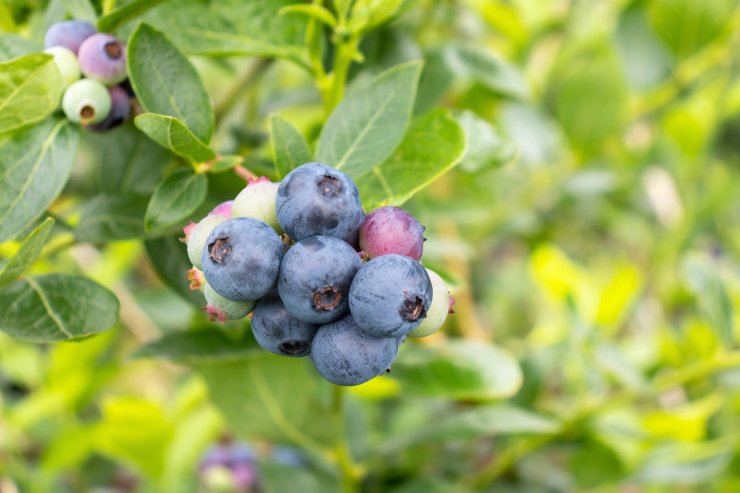
Northern Highbush Blueberries
The northern highbush blueberry is what we’ve come to know as the common blueberry: it’s the berry we see at farm stands and at the market. Plump, big, and a rich, deep blue. It’s native to the eastern and northeastern United States.
Northern highbush plants grow to a height of 6 to 12 feet; hence their name. Keep their size in mind as you choose the type of blueberry plants you want for your garden.
Just like their lowbush counterparts, northern highbush blueberries crave acidic soil and full sun. If you have land near a marsh, swamp, or lake, your blueberry plants will be pretty happy; that’s their native habitat. But you can also grow them in drier areas, such as woods, rocky hillsides, and sandy soil. They’re fairly forgiving, so if you don’t have a strong green thumb, not to worry. Just make sure your soil has the right composition.
Quick tip: If your soil needs more acidity, add coffee grounds, and then check the acid level again.
Northern highbush blueberries do require consistent pruning to help them thrive. If you don’t prune them, they can become overgrown—and they’ll produce less fruit. Pruning is a fairly straightforward process. Remove any lower growth to prevent fruit from settling on the ground. Once a year, in the winter, you should remove the two oldest canes (main stems). Your goal is to clear the way for sunlight to get to the center of the plant. So, if you have any branches that overlap, at least one of them will have to go.
With proper soil and pruning, northern highbush plants will produce fruit from mid- or late July until mid-August. If you don’t want the birds to get all your berries, protect your plants with netting. You’ll actually get more berries sooner if you have more than one highbush variety; cross-pollination makes the plants more prolific.
Northern highbush cultivars include:
- Bluecrop
- Bluejay
- Blueray
- Duke
- Elliot
- Hardyblue
- Jersey
- Legacy
- Patriot
- Rubel (Remember Rubel? One of the originals! See Introduction section for the history of this cultivar.)
Have you ever grown northern highbush blueberries? How successful were you with your crop? Please share in the comment section below your tips for growing northern highbush blueberries.


 Previous
Previous


I have grown northern high bush blueberries for about 20 yrs now! I absolutely love them. I live in central Connecticut and they are in the wettest part of the yard! They get sun all day long. I feed them once in the spring. I have 7 bushes and the amount of blueberries we get from them is phenomenal! I need to learn how to prune them properly!
I bet you get some great blueberries from your 7 bushes! In our Blueberry Gardening Guide we have a section on Fertilizing and Pruning Your Blueberry Plants you can find it here: https://foodgardening.mequoda.com/articles/fertilizing-and-pruning-your-blueberry-plants/?t=328